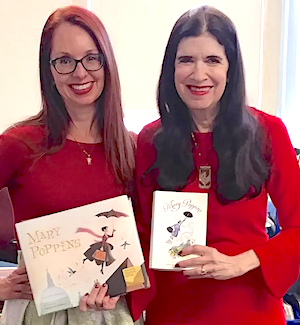http://literacyspecialinterest.blogspot.com/2019/03/mary-poppins-pops-into-21st-century.html
"How a Spoonful of Sugar Helped Our Book Study
Reading and studying books is a perennial classroom activity; one that may be experienced by students as sheer drudgery or one that can be engaging, exhilarating, and satisfying.
Which variety of experience teachers offer depends on which book is selected and how it is taught.
Over the years we’ve cracked the code for implementing book units that have our middle grades students enthralled, with imaginations fired up, and looking forward to future book studies when the unit is over.
One part of our approach is to select a book that is associated with current pop culture movies, like the popular Mary Poppins Returns released last December.
Most young people love to read about magical characters who can fix the negative realities described in a story. This is a classic theme across literature, including adult books, but an especially strong and beloved technique in books written for youngsters.
Magical characters like Peter Pan who fled a negative world to a never-never land of childhood win devoted audiences for their authors. Mary Poppins is a defiant “life fixer” who swoops in with empathy and wise guidance and precipitates magic and joy. She is also softer and less violent than the many modern-day popular characters like Marvel superheroes. She offers tenderness and hope for students.
Why Mary Poppins?
Mary Poppins has a long history of being a much-loved character. She
was introduced back in 1934, after then-actress and journalist P.L. Travers spent some convalescent time developing a simmering idea into her first novel.Many adults involved in today’s students’ lives know and are nostalgic for Mary Poppins, making inter-generational sharing of the book series and movies an especially rich experience.
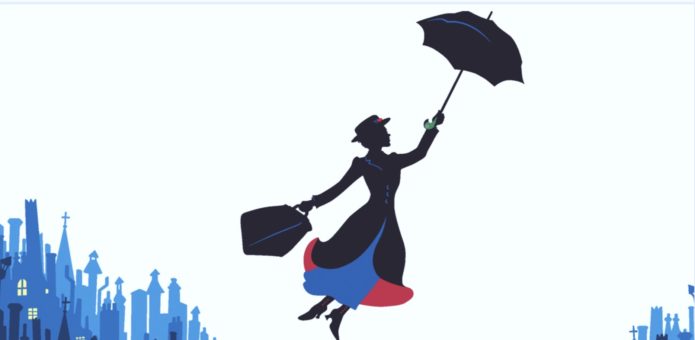
from Mary Poppins – The Musical (Study Guide)
The 2018 film, Mary Poppins Returns, with musical and visual references mirroring the original and internationally known 1964 version, traces a complex lineage all the way back to 1934 when the first in a series of eight Mary Poppins books was published and became a perennially favorite piece of young people’s literature. Australian-British writer Travers kept the series going through 1988.
When trailers for the Mary Poppins Returns movie were released, Rose immediately sensed that there was a potentially rich teachable moment unfolding. As a child Rose had read the print book and liked the independent nature of Mary Poppins who did not take orders from her employer. Amanda was also a fan of the print character as a child. We both loved the 1964 movie as did many of our colleagues who grew up in the late 80’s and 90’s.
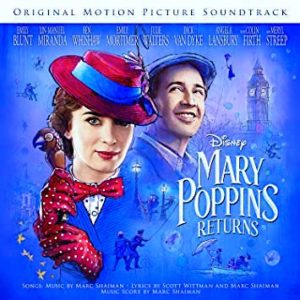
The fact that there is an extensive body of work on this appealing character and her ever unfolding story – and also that so much of this is in digital format, online, and free and easily accessible for teachers everywhere – makes the Mary Poppins theme all the more significant to teachers who are willing to take a chance on a classic storyline.
Consequently, we sat down, planned and implemented the following activities with Ms. Xavier’s classes of sixth graders at Brooklyn’s Ditmas Junior High in Brooklyn, NY. The result was so successful, the students so fired up and engaged, that we wanted to share some details with colleagues who may wish to implement some or all of it as we did. If Mary Poppins is just not your cup of tea, perhaps you’ll distill some ideas from our planning and apply them to other themes.
A “Book” Is More Than a Book
One of the important leaps that literacy educators are currently making is transforming their practice to embrace the concept that “book” means more than simply many pages of text-bearing paper bound between two covers. And by “more” we don’t mean simply a downloadable e-book version.Rather, the 21st century book embraces a synergy of numerous contemporary content formats – web published text, online video and audio, and more – all working with one another to produce a single, engaging, media rich experience.
Which brings us to the 21st century classroom. As is laid out perfectly in the UDL (Universal Design for Learning) body of theory, teachers should engage readers by addressing their wide variety of needs and styles through flexible and varied content formats. These may include moving and still visual elements, dramatic film sequences, the music and lyrics of songs, as well as print text.
In view of this new understanding of books, and the fact that we were much taken with the popularity of the original movie and the strength of the original novel as a focus for book study, we planned a unit on Mary Poppins.
Interestingly, we did not have access to multiple copies of any of the Mary Poppins books. We decided to present our students with a rich Mary Poppins experience anyway, using some of the free and easy-to-access digital resources available.
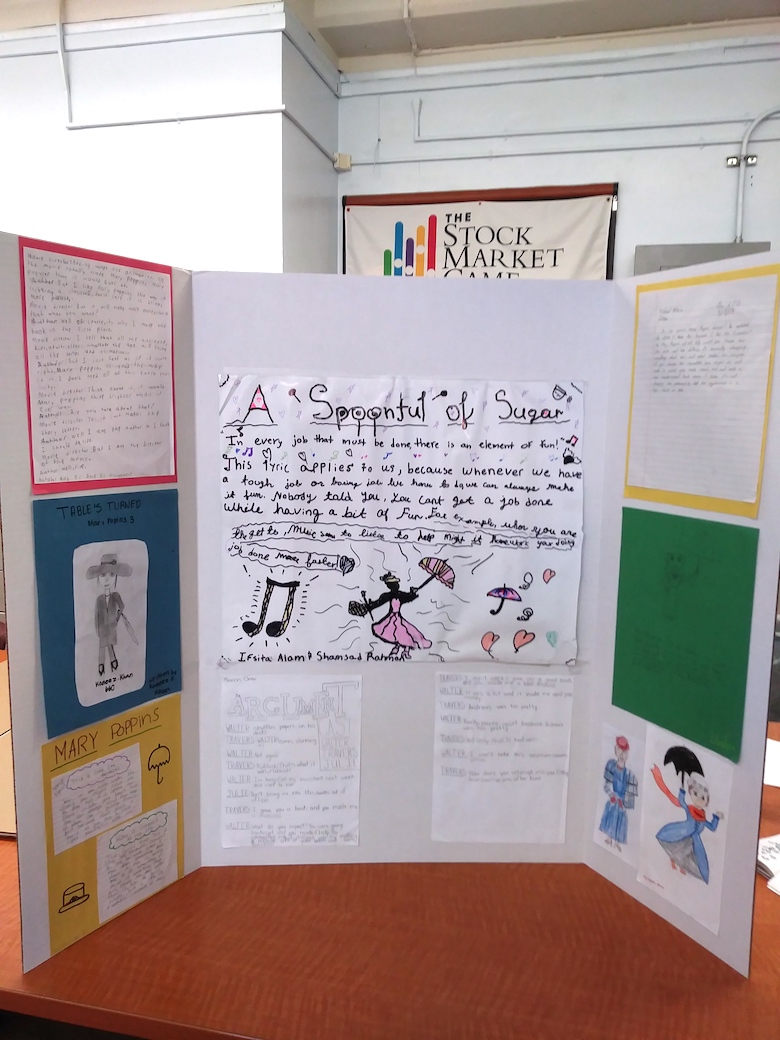
Here’s Some of What We Did
Introducing the Mary Poppins theme was accomplished by having the students view several of the very accessible and short movie trailers found on YouTube. These are perfect for short, 50 minute classes and, importantly, these are so skillfully produced that even though they are only 4 to 7 minutes long they motivated our students to move on to content provided in other more challenging formats.Prior Knowledge Pre-assessment
The night before the lesson we had students ask their parents and family/friends what they knew about Mary Poppins and talk about their experiences with her. We had them write and date their pre-assessment, sharing what they discovered. We allowed them to discuss their responses and their parents’ connections to Mary without commenting ourselves.Among other activities, we challenged them to reflect on what a nanny does and if there are jobs like this around today. You may want to share the GoNannies website after the activities to solidify and extend the conversation.
We told the students that a British author wrote this story and a series of other Mary Poppins books, beginning back in 1934, almost 100 years ago. We had some discussion: given that there are many successful American authors writing today, should they be studying this work, or would a work published currently be a better focus?
We asked those who enjoy art to draw the Mary Poppins character. We helped them to define her in art as a character by asking what dress and accessories she always has. These include: umbrella, hat, kite, carpet handbag, etc.
We returned to this pre-assessment discussion at the end of these activities and had the students share what they learned from this start.
Reading across various formats
A great activity to get students to think about plot, plot sequels, and the flow from one to the other is to have them read the beginning and end of a book and predict a sequel or prequel. While a class set of the books on which the 1964 movie is based may not be available, the movie itself can be found on DVD or streamed.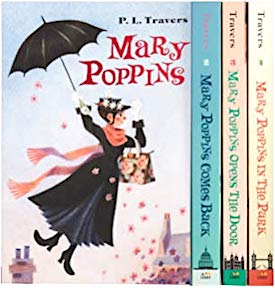
Since the Mary Poppins Returns movie (2018) is a sequel to the first Disney film done in 1964 and Mary Poppins Comes Back (1935) was the actual print sequel written by Travers, we had students review the last page of the first Mary Poppins book (1934). Large segments of both the original book and the first sequel are available online at Google Books. Students can also look at the 1964 Disney film script and read the final pages to inspire a plausible sequel given the last lines.
Our students then wrote a beginning of the print sequel. They storyboarded their ideas of how to create a sequel from the known ending given in the original book, but a purely text outline would suffice.
Of course the writers of the 2018 film created their own sequel, but our writing activity pushes kids, as engaged readers and writers. Explain to the students that by working from the original’s last page, multiple beginnings of the sequel are possible and it is very likely that the writers of the new movie created and debated many possibilities before selecting the one that made it into the movie.
Other possible activities
Our students had not yet seen the new Mary Poppins movie (released in December 2018) with Emily Blunt and Lin-Manuel Miranda, so this idea worked well for us. It’s a strategy that might be used with other classic book-related films that are being updated before the new versions are released.We showed the students the 4-minute online trailer of the original 1964 film available at YouTube. We asked them to watch for things they thought might be needed to update this movie for the sequel. Should it be switched to the United States? Should it take place in the 21st century? Should Mary’s wardrobe be updated to have different fashions? Should the same main characters be used or different ones, perhaps related in some way to the same characters?
We allowed them to talk about their choices and told them that even if the writers of the film they were eventually going to see did not use ideas like theirs, they were exercising their own creative thinking skills.
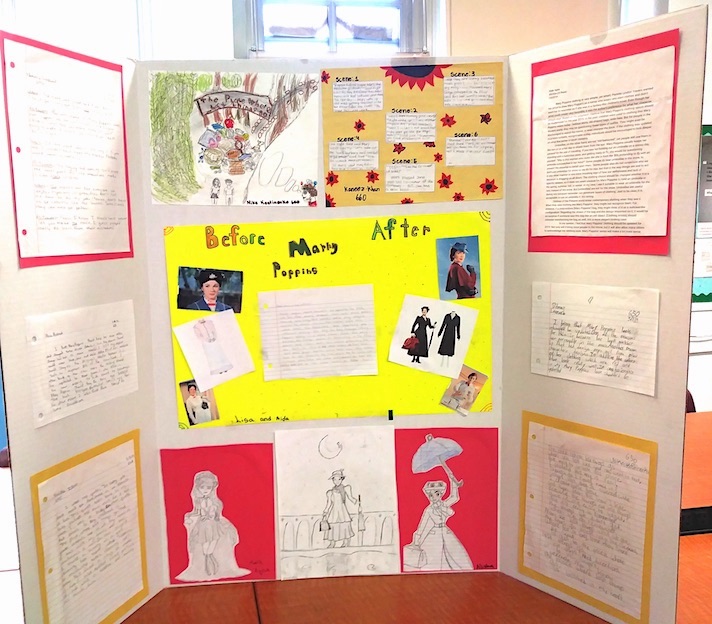
We then extended the discussion by showing them several trailers from the upcoming Mary Poppins Returns (see here and here) and talked about them in the context of our various activities. Some students did “before and after” display boards to share what they learned with other students in our school.
Long live Mary Poppins!
Consultant Rose Reissman: Who says Mary Poppins can’t be the practically perfect character for 21st century kids’ literature – or at the very least, the focus of their passionate arguments about her?The strategies suggested here focus on our use of free digital trailers and accessible recordings of songs and interviews that can help introduce today’s students to children’s classics of the past. This is both a cost-effective way to acquire an abundant body of rich instructional materials, as well as a way to introduce today’s audiences to great works of the past.
We also like using a visual entry point to motivate and generate interest in the print text. Whatever PL Travers may have thought about them, the film versions of Mary Poppins will help assure ongoing popularity of her print books.
Teacher Amanda Xavier: Harkening back to days of yore has a certain appeal as we grow older. But does this have a place in the modern ELA classroom? Should students be introduced to older works of fiction, or should the emphasis be on modern tales that encapsulate modern dilemmas and ideals?
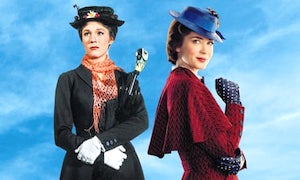
I tend to use more up-to-date books with my classes, mostly because I get tired of doing the same old thing year in and year out. So imagine my surprise, while working with Dr. Rose Reissman, about the enthusiasm my classes showed to creating responses to Mary Poppins.
If any book is dated and out of touch with contemporary kids in a Brooklyn middle school, Mary Poppins would seem to be it. But my kids loved her. Really loved her.
The visceral connection many felt to the lyrics we showed from both movies was amazing. The kids got her. The simple lessons of picking yourself up, dusting yourself off, and getting out there again – or the sentimentality of a slow, sweet song – was not lost on them. They enjoyed creating storyboards for the beginning of Mary Poppins Returns and were great at it.
So yes, everything has its day and then passes into nostalgia. But if a very old fashioned nanny can bring smiles and make modern kids sit up in class and take note of her very topical lessons, I say, “Cheerio, Mary Poppins.”
As part of Amanda
Xavier’s Mary Poppins Enters the 21st Century Project, students were
asked to compare and to contrast the various moods, tone, and film
styles of the 2018 version of Mary Poppins versus the 1964 version. Read their astute filmgoer responses here.
More Online Resources
Mary Poppins Chatterbooks resources (UK – PDF)How Mary Poppins Returns reinvents the beloved nanny for the 21st Century
How to Write a Nanny Job Description (FullTime Nanny website)
Lin-Manuel Miranda Shares What Being in Mary Poppins Returns Means to Him
___________________________________
Dr. Rose Reissman is the founder of the Writing Institute, now replicated in 200 schools. This project was developed with students at Ditmas Junior High (IS 62) in Brooklyn NY, led by Principal Marielena Santiago and Assistant Principal Michelle Buitrago. The Writing Institute Team includes Michael Downes, Angelo Carideo, and Amanda Xavier.
Amanda Xavier is a New York State permanently certified Common Branch K-6 teacher. She began her teaching career in 2001 in Brooklyn, NY where she taught all subjects in 5th grade for five years. She’s been teaching 6th grade ELA since 2006.
